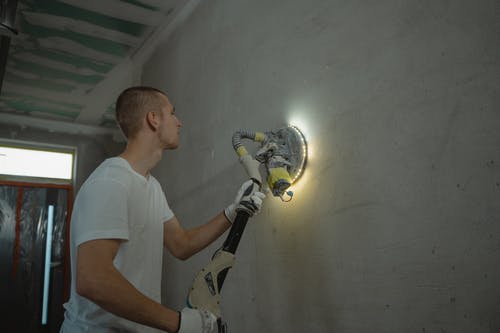How To Paint A Rendered Wall
If you’re looking for a quick and easy way to give your home a fresh new look, painting a rendered wall is the way to go! Rendered walls are often found in older homes, but they can be painted any color you like to match your decor. Here’s how to get the job done right.

What is a rendered wall?
A rendered wall is a wall that has been covered in a thin layer of cement. This gives the wall a smooth, textured surface that can be painted or left as is. Rendered exterior walls are used to improve their appearance and protect them from weather damage. It can also be used on interior walls to create a unique look.
Cement render is a fairly simple process, but it requires some basic knowledge and skills. First, the wall must be cleaned and any loose debris removed. Next, a thin layer of cement is applied to the surface using a trowel. The cement is then smoothed out until it forms an even surface. Once the loose render is dry, it can be painted or left as is.
Is it possible to paint on a rendered wall?
A rendered wall is a wall that has been coated with a mixture of cement, sand, and water. This mixture is then smoothed over the surface of the wall to create a smooth, even finish. Once the render has dried, you can easily paint rendered walls. However, it is important to choose the right type of paint for the job.
High-quality acrylic paints or latex paints will adhere well to the surface of the render and provide good coverage. In addition, it is important to prepare the surface of the render before painting. This can be done by sanding down any rough areas and cleaning the surface with a mild detergent. By taking these steps, you can ensure that your paint job will be long-lasting and look great for years to come.
Factors to consider before painting a rendered wall
Before painting a rendered wall, there are a few factors to consider. The first is the type of render. Smooth renders are easier to paint than textured ones, but they can be more prone to cracks and imperfections. The second factor is the surface of the render. If it is very old or has been damaged, it may need to be repaired before painting.
The third factor is the type of paint you want to use. Water-based paints are less likely to crack and peel, but they may not adhere as well to surfaces that are very old or damaged. Ultimately, the best way to decide which type of paint to use is to consult with a professional painter or contractor. They will be able to assess the condition of the render and recommend the best type of paint for the job.
What type of paint is suitable for rendered walls?
Render is a popular finish for exterior walls as it provides a smooth, even surface that can be easily painted. However, not all types of paint are suitable for use on rendered walls. Acrylic paint is a good option as it is water-based and will not cause the render to blister or peel. For a more durable finish, use an acrylic urethane paint.
This type of paint is more resistant to chipping and fading, making it a good choice for rough surface areas that are exposed to direct sunlight or high traffic. With so many options available, choosing the right type of paint for your rendered wall can be a daunting task. However, by following these simple guidelines, you can ensure that your finished project will look great and last for years to come.
Step-to-step guide on how to paint a rendered wall
A rendered wall is a wall that has been coated with a cement- or plaster-based mixture. Once the mixture has dried, it will create a smooth, even surface that can be painted. If you want to add some color to your rendered wall, follow these steps:
- Begin by cleaning the surface of the wall with a power washer or high-pressure hose. This will remove any dirt or debris that could prevent the paint from adhering properly.
- Once the wall is clean, apply a primer using a roller or paint brush. This will help the paint to adhere better and provide a more even finish.
- Once the primer is dry, you can begin painting the wall with your chosen color. Start at the top of the wall and work your way down, using a roller or brush to evenly distribute the paint.
- Allow the paint to dry completely before applying a second coat if desired. Once the second coat is dry, you can enjoy your newly rendered wall!
Do you need to seal the render before painting?
When it comes to doing the exterior wall paint of your home, one important question to ask is whether or not you need to seal the render before painting. While sealing is not always necessary, there are some situations where it can be helpful. For example, if you are painting over flaking paint or if you are painting a new render, sealing can help to create a smooth surface and prevent the new paint from peeling.
If you’re not sure whether or not you need to paint render after sealing, it’s always best to consult with a professional painter. They will be able to assess the condition of your render and advise you on the best course of action. In most cases, lay drop sheets and start by painting the render with two coats of exterior paint. But in some situations, sealing render before painting may be the best option.



